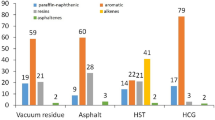Abstract
The optimum carbonization conditions for converting a low-sulphur petroleum vacuum residue in a tube bomb in terms of pressure and temperature into better needle coke of low CTE, with less production of poor bottom coke, were studied by observation of the resultant cokes and sequential analyses of carbonization intermediates by means of solvent fractionation and gas evolution. Carbonization at 460°C under 15 kg cm−2 G produced the best needle coke. The quality of the resultant needle coke was strongly influenced by viscosity changes of the system, the solidification range and gas evolution in the carbonization progress. The first two characteristics reflect the rates of condensation (such as QI formation) and devolatilization of soluble fractions, strongly influencing the growth of anisotropic units. The last characteristic reflects the pyrolytic cracking reaction to define the timing of gas evolution during carbonization, influencing the axial orientation of anisotropic texture as well as the porosity in the resultant coke. Both profiles varied very much, depending on the carbonization temperature. Finally, the formation of a bottom coke of fine mosaic texture is discussed from the viewpoint of the co-carbonization concept.
Similar content being viewed by others
References
H. Marsh, F. Dachille, J. Malvin andP. L. Walker Jr,Carbon 9 (1971) 159.
Heavy Oil Division, Refining Section of the Japan Petroleum Institute,J. Jpn Petrol. Inst. 24 (1981) 44.
Idem, ibid. 24 (1981) 54.
M. Kakuta, T. Tsuchiya andM. Kooriki,Tanso 85 (1976) 55.
I. Mochida, Y. Korai, Y. Nesumi andT. Oyama,Ind. Eng. Chem. Prod. Res. Dev. 25 (1986) 198.
I. Mochida, T. Oyama, Y. Nesumi andY. Korai,Carbon 25 (1987) 259.
I. Mochida, T. Oyama andY. Korai,ibid. in press.
M. Kakuta, M. Kooriki andY. Sanada,J. Jpn Petrol. Inst. 20 (1977) 557.
I. Mochida, T. Oyama andY. Korai,Carbon, in press.
J. K. Brown andW. R. Lander,Fuel 39 (1960) 79.
I. Mochida, Y. Q. Fei, T. Oyama, Y. Korai andH. Fujitsu,J. Mater. Sci. 22 (1987) 3989.
H. Honda, H. Kimura andY. Sanada,Carbon 9 (1971) 695.
S. Eser, R. G. Jenkins andF. J. Derbyshire,ibid. 24 (1986) 77.
Author information
Authors and Affiliations
Rights and permissions
About this article
Cite this article
Mochida, I., Oyama, T., Fei, Y.Q. et al. Optimization of carbonization conditions for needle coke production from a low-sulphur petroleum vacuum residue. J Mater Sci 23, 298–304 (1988). https://doi.org/10.1007/BF01174069
Received:
Accepted:
Issue Date:
DOI: https://doi.org/10.1007/BF01174069



